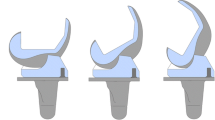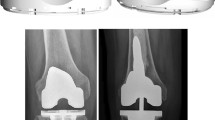Abstract
Introduction
Patients with knee osteoarthritis tend to modify spatial and temporal parameters during walking to reduce the pain. Total knee arthroplasty (TKA) is considered the gold standard treatment for end-stage knee osteoarthritis. However, reduced physical function of the knee is partly, but apparently not fully, remedied by surgery. The purpose of this study was to investigate the in vivo, three dimensional knee kinematics during gait at the patients with knee osteoarthritis and the influence of “third condyle” psoterior stabilized (PS) total knee arthroplasty on restoration of normal kinematics.
Materials and Methods
Twenty patients with medial knee osteoarthritis and a control group with age-matched subjects were prospectively collected for this study. The same group of 20 patients were re-assessed 10 months after total knee arthroplasty with “third condyle” PS prosthesis. All subjects were assessed with a 3D, optoelectric knee assessement device, while walking on a treadmill at a self-selected speed. For each participant, knee flexion–extension, abduction–adduction, internal–external rotation and anterior–posterior displacement, were calculated.
Results
The range of flexion/extension was improved significantly (39.9° ± 5.5° vs 44.8° ± 5.1°, p < 0.05) after TKA but it still remained lower than control group (6.9° ± 5.5° vs 2.2° ± 3.9°, p < 0.05). The range of motion in internal-external rotation did not change pre- and post-arthroplasty, but remained lower than the matched control group (6.7° ± 2.4° vs 9.3° ± 2.4, p < 0.05). The maximum posterior displacement during swing phase was significantly higher at post-arthroplasty group comparing with control group (−9.5 ± 2.2 vs −5.7 ± 3 mm, p < 0.05).
Conclusion
Following “third condyle” PS-TKA, patients had better clinical, spatiotemporal and kinematic parameters. Despite improvements, the knee kinematics during gait in TKA group differed from healthy control group. TKA group had a lower extension lower range of axial rotation and an increased tibial posterior displacement.






Similar content being viewed by others
References
Minoda Y, Ikebuchi M, Mizokawa S, Ohta Y, Nakamura H (2016) Mobile-bearing TKA improved the anteroposterior joint stability in mid-flexion range comparing to fixed-bearing TKA. Arch Orthop Trauma Surg 136(11):1601–1606
Vahtrik D, Ereline J, Gapeyeva H, Pääsuke M (2014) Postural stability in relation to anthropometric and functional characteristics in women with knee osteoarthritis following total knee arthroplasty. Arch Orthop Trauma Surg 134(5):685–692
Stoddard JE, Deehan DJ, Bull AMJ et al (2013) The kinematics and stability of single-radius versus multi-radius femoral components related to Mid-range instability after TKA. J Orthop Res 31:53–58. doi:10.1002/jor.22170
Ezechieli M, Dietzek J, Becher C, et al (2012) The influence of a single-radius-design on the knee stability. Technol Heal Care 20:527–534. doi:10.3233/THC-2012-0698
Schlepckow P (1992) Three-dimensional kinematics of total knee replacement systems. Arch Orthop Trauma Surg 111:204–209. doi:10.1007/BF00571478
McEwen HMJ, Barnett PI, Bell CJ et al (2005) The influence of design, materials and kinematics on the in vitro wear of total knee replacements. J Biomech 38:357–365. doi:10.1016/j.jbiomech.2004.02.015
Siebold R, Louisia S, Canty J, Bartlett RJ (2007) Posterior stability in fixed-bearing versus mobile-bearing total knee replacement: a radiological comparison of two implants. Arch Orthop Trauma Surg 127:97–104. doi:10.1007/s00402-006-0232-4
Tayot O, Aït Si Selmi T, Neyret P (2001) Results at 11.5 years of a series of 376 posterior stabilized HLS1 total knee replacements. Survivorship analysis, and risk factors for failure. Knee 8:195–205
Demey G, Servien E, Lustig S et al (2011) Cemented versus uncemented femoral components in total knee arthroplasty. Knee Surg Sports Traumatol Arthrosc 19:1053–1059. doi:10.1007/s00167-010-1347-2
McClelland J a, Webster KE, Feller J a, Menz HB (2011) Knee kinematics during walking at different speeds in people who have undergone total knee replacement. Knee 18:151–155. doi:10.1016/j.knee.2010.04.005
Graves SE, Davidson D, Ingerson L, et al (2004) The Australian orthopaedic association national joint replacement registry. Med J Aust. doi:gra10571_fm [pii]
Labbe DR, Hagemeister N, Tremblay M, de Guise J (2008) Reliability of a method for analyzing three-dimensional knee kinematics during gait. Gait Posture 28:170–174. doi:10.1016/j.gaitpost.2007.11.002
Hagemeister N, Parent G, Van de Putte M et al (2005) A reproducible method for studying three-dimensional knee kinematics. J Biomech 38:1926–1931. doi:10.1016/j.jbiomech.2005.05.013
Südhoff I, Van Driessche S, Laporte S et al (2007) Comparing three attachment systems used to determine knee kinematics during gait. Gait Posture 25:533–543. doi:10.1016/j.gaitpost.2006.06.002
Magnussen RA, Neyret P, Cheze L, Lustig S (2012) The KneeKG system: a review of the literature. Knee Surg Sport Traumatol Arthrosc 20:633–638. doi:10.1007/s00167-011-1867-4
Bytyqi D, Shabani B, Lustig S et al (2014) Gait knee kinematic alterations in medial osteoarthritis: Three dimensional assessment. Int Orthop 38:1191–1198. doi:10.1007/s00264-014-2312-3
Baker R (2003) ISB recommendation on definition of joint coordinate systems for the reporting of human joint motion—Part I: ankle, hip and spine. J Biomech 36:300–304. doi:10.1016/S0021-9290(02)00336-6
Hatfield GL, Hubley-Kozey CL, Astephen Wilson JL, Dunbar MJ (2011) The effect of total knee arthroplasty on knee joint kinematics and kinetics during gait. J Arthroplasty 26:309–318. doi:10.1016/j.arth.2010.03.021
Mandeville D, Osternig LR, Chou L-S (2007) The effect of total knee replacement on dynamic support of the body during walking and stair ascent. Clin Biomech (Bristol Avon) 22:787–794. doi:10.1016/j.clinbiomech.2007.04.002
Saari T, Tranberg R, Zügner R et al (2005) Changed gait pattern in patients with total knee arthroplasty but minimal influence of tibial insert design. Acta Orthop 76:253–260. doi:10.1080/00016470510030661
Saari T, Carlsson L, Karlsson J, Kärrholm J (2005) Knee kinematics in medial arthrosis. Dynamic radiostereometry during active extension and weight-bearing. J Biomech 38:285–292. doi:10.1016/j.jbiomech.2004.02.009
Yue B, Varadarajan KM, Moynihan AL, et al (2011) Kinematics of medial osteoarthritic knees before and after posterior cruciate ligament retaining total knee arthroplasty. J Orthop Res. doi:10.1002/jor.21203
Dennis DA, Komistek RD, Mahfouz MR, et al (2004) A multicenter analysis of axial femorotibial rotation after total knee arthroplasty. Clin Orthop Relat Res. doi:10.1097/01.blo.0000148777.98244.84
Uvehammer J, Kärrholm J, Brandsson S (2000) In vivo kinematics of total knee arthroplasty. J Bone Joint Surg Br 82:4–10
van der Linden ML, Rowe PJ, Myles CM et al (2007) Knee kinematics in functional activities seven years after total knee arthroplasty. Clin Biomech (Bristol Avon) 22:537–542. doi:10.1016/j.clinbiomech.2006.12.005
Author information
Authors and Affiliations
Corresponding author
Ethics declarations
Conflict of interest
Authors Bytyqi Dafina, Shabani Bujar, Cheze Laurence declare that they have no conflict of interest. Sébastien Lustig is consultant for Smith and Nephew and received institutional support from Amplitude and Wright-Tornier. Philippe Neyret received royalties from Wright-Tornier and institutional support from Amplitude and Wright-Tornier.
Ethical approval
All procedures performed in studies involving human participants were in accordance with the ethical standards of the institutional and/or national research committee and with the 1964 Helsinki declaration and its later amendments or comparable ethical standards.
Informed consent
Informed consent was obtained from all individual participants included in the study.
Rights and permissions
About this article
Cite this article
Bytyqi, D., Shabani, B., Cheze, L. et al. Does a third condyle TKA restore normal gait kinematics in varus knees? In vivo knee kinematic analysis. Arch Orthop Trauma Surg 137, 409–416 (2017). https://doi.org/10.1007/s00402-017-2629-7
Received:
Published:
Issue Date:
DOI: https://doi.org/10.1007/s00402-017-2629-7




